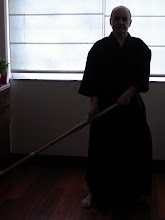First, and in order of importance, we have what is commonly known in the West as shomen, but it is also equivalent to the term “shinzen“. This has to be located at the opposite end of the entrance door of the dojo. Here is where,if the case, the “ kamidana ” or Shinto shrine is to be placed. It is the spot of greatest excellence or supremacy in the dojo. If we see vintage Japanese films, orjidaigeki, we would see that this is where the Tonosama is placed. Bringing this concept to kendo, in the case of events or championships, here stands the Royal Box, among other members of the royal or imperial family will be seated.
On the other hand, we find the kamiza (or “jouseki“). In this regard we will point out for those who may have certain Japanese language notions that the term kamizahas nothing to do with kamisama or “divinity”, but the characters that compose this word mean literally “seat up”. It is a term also used in the Japanese daily life, and it refers to where the “higher grade” person has to be sit. In Japanese daily life there is a complex system about where exactly this place is situated, depending on the type of room or location and the surrounding elements (of what I hope to talk in some offtopic article). Applied to Kendo, and as most of you will have guessed, this is the place where the sensei sits, and it usually refers to right side of the shomen, where the highest grade is located closest to it, and the rest of them are positioned so that the lower grade is in the furthest place from the shomen.
An interesting point, in case anyone has also wondered: “Why do the senseis do not sit on the side of shomen?”. The answer is that if so, it would be entirely disrespectful to show one’s back to the divinity, and equally it would be wrong to turn away from the guests of honor.
Finally, and in contrast to this concept of kamiza is the “shimoza”, which is the place where the person with the lesser degree at that time shall situate, and it corresponds to the farthest spot from the shomen.
This would be roughly the distribution of a dojo, but these general rules can vary to suit the situation and characteristics of each place. As always, what is important is to adapt to the rules existing in each place, and in no case want to impose what we believe is right.
Tomado de y más información en: http://www.aranami-madrid.es/en/la-composicion-de-un-dojo/





No hay comentarios:
Publicar un comentario